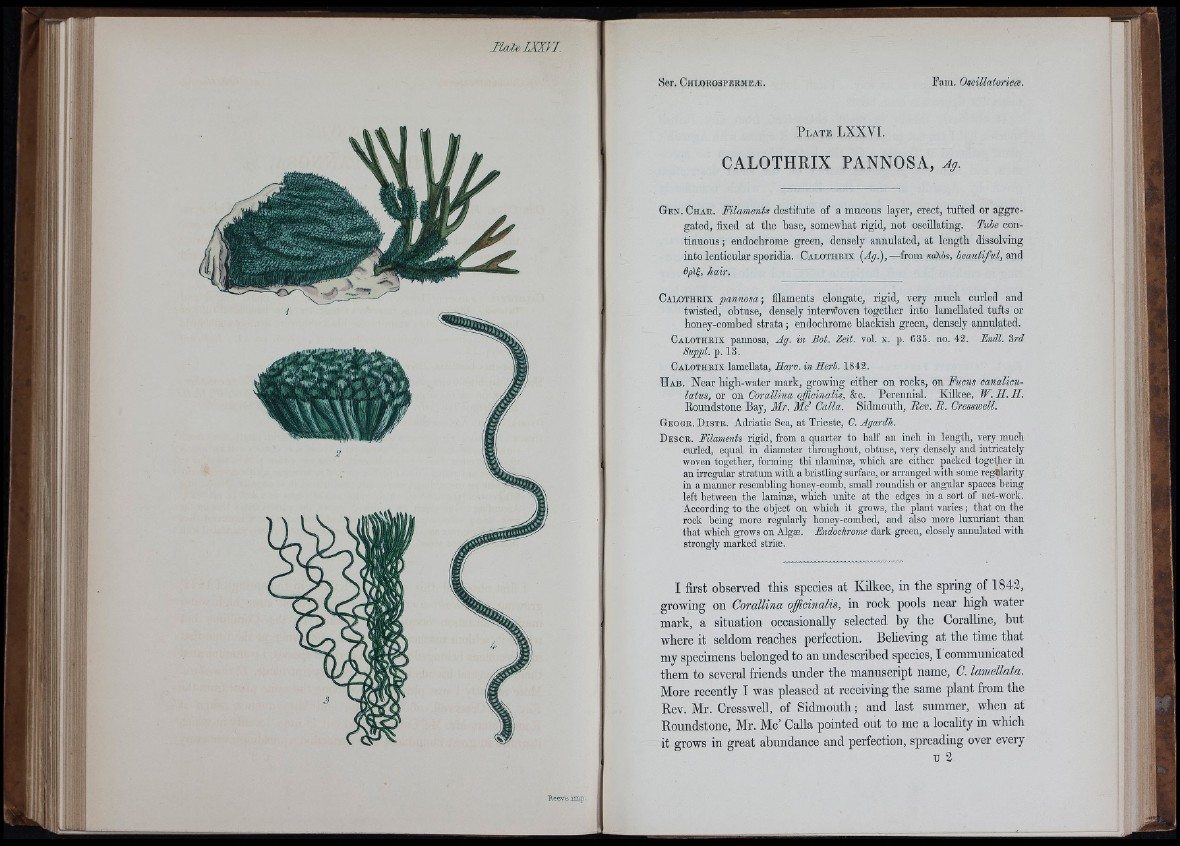
Ilo ü te LX X V I.
Reeveimp.
CALOTHRIX PANNOSA, Ag.
G e n . C h a e . Filaments destitute of a mucous layer, erect, tufted or aggregated,
fixed a t tlie base, somewhat rigid, not oscillating. Tube contin
u o u s ; endochrome green, densely annulated, at length dissolving
into lenticular sporidia. C a l o t h r i x [Ag.),—from raXbs, beautiful, wA
6p\^, ,
C a l o t h e i x pannosa; filaments elongate, rigid, very much curled and
twisted, obtuse, densely interwoven together into lamellated tu fts or
honey-combed stra ta ; endochrome blackish green, densely annulated.
Ca l o t h r ix pannosa, Ag. in Bot. Zeit. vol. x. p. 635. no. 43. Endl. 3rd
Suppl. p. 13.
Ca l o t h e ix lameUata, Harv. in Herb. 1842.
H a b . Ne a r high-water mark, growing either on rocks, on Fucus eanalicu-
latus, or on Corallina officinalis, &o. Perennial. Kilkee, W. H. H.
Eoundstone Bay, Mr. Md Calla. Sidmouth, Rev. R . Cresswell.
G e o g e . D is t r . Adriatic Sea, at Trieste, C. Agardh.
D e s c r . Filaments rigid, from a quarter to half an inch in length, very much
curled, equal in diameter throughont, obtuse, very densely and intricately
woven together, forming thi nlaminæ, which are either packed together in
an irregular stratum with a bristling surface, or arranged with some regSlarity
in a manner resembling honey-comb, small roundish or angular spaces being
left between the laminae, which unite at the edges in a sort of net-work.
According to the object on which it grows, the plant varies ; that on the
rock being more regularly honey-combed, and also more luxuriant than
that which grows on Algae. Endochrome dark green, closely annulated with
strongly marked striae.
I first observed tbis species at Kilkee, in tbe spring of 1843,
growing on Corallina officinalis, in rock pools near bigb water
mark, a situation occasionally selected by the Coralline, but
where it seldom reaches perfection. Believing at tbe time tbat
my specimens belonged to an midescribed species, I communicated
them to several friends under the manuscript name, C. lamellata.
More recently I was pleased at receiving the same plant from tbe
Bev. Mr. Cresswell, of Sidmouth; and last summer, when at
Boundstone, Mr. Me’ Calla pointed out to me a locality in which
it grows in great abundance and perfection, spreading over every
u 2
IC l
il r.
lb.',.